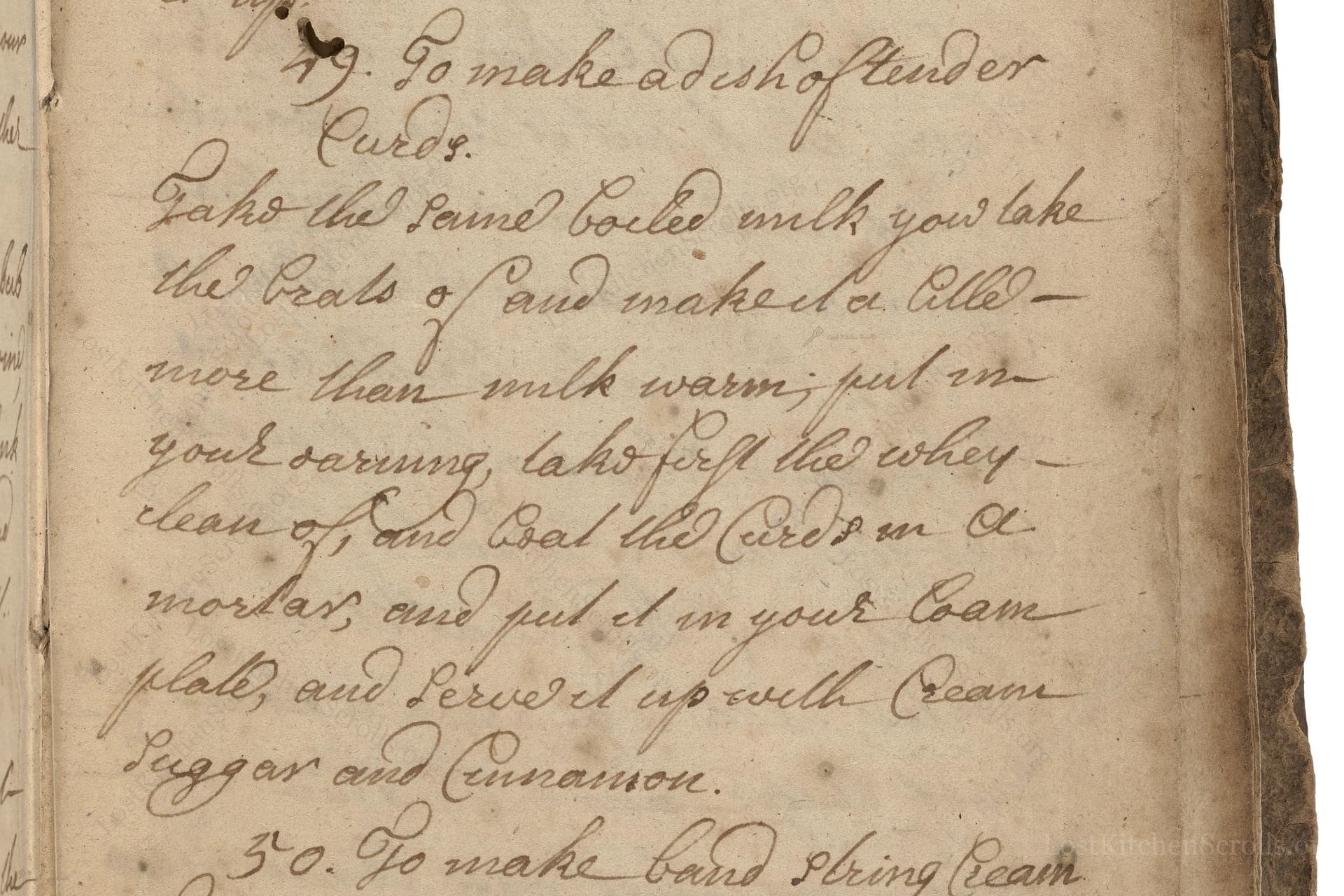
To Make A Dish Of Tender Curds
"Take the same boiled milk you take the brals of and make it a little more than milk warm; put in your sarving, take first the whey clean of, and beat the curds in a mortar; and put it in your Coam plate, and serve it up with Cream Suggar and Cinnamon."
Note on the Original Text
The recipe is written in the instructive and somewhat elliptical style of early modern English cookery manuscripts—using imperative verbs, omitting specified quantities, and assuming familiarity with basic techniques. Spellings ('sarving' for 'serving', 'coam' for 'comely' or 'common') reflect phonetic variations of the time. The term 'brals of' indicates taking the cream (or top) from milk after settling. Recipes were passed down and recorded for those already adept in the kitchen, leaving plenty of room for personal interpretation.

Title
Receipts for cookery and pastry work (1700)
You can also click the book image above to peruse the original tome
Writer
Mrs. Johnston
Era
1700
Publisher
Unknown
Background
A delightful compilation of 18th-century recipes gathered by Mrs. Johnston herself, promising a charming journey through the flavors and culinary traditions of the early 1700s.
Kindly made available by
Folger Shakespeare Library
This recipe comes from the turn of the 18th century, a time when households commonly made their own dairy products, including curds and cream. In early modern England, dishes like these were enjoyed as light desserts or comforting snacks, especially by the gentry. The compilers of these manuscripts, such as Mrs. Johnston, were often ladies of the household, keen to record and perfect the art of cookery passed down through generations. The recipe reflects a domestic setting where milk was fresh from the dairy, and sweet spices like cinnamon were prized additions.

Historically, the milk would have been heated over an open fire or hearth, likely in a cast iron or copper pan. Once curdled, curds would be beaten with a mortar and pestle—an essential tool for fine softening. The finished curds would be piled onto a faience or silver serving plate (referred to as a 'Coam plate'), before being lavishly garnished.
Prep Time
25 mins
Cook Time
10 mins
Servings
4
We've done our best to adapt this historical recipe for modern kitchens, but some details may still need refinement. We warmly welcome feedback from fellow cooks and culinary historians — your insights support the entire community!
Ingredients
- 1 quart whole milk
- 1/2 tsp liquid rennet (or 1 tbsp lemon juice as substitute)
- 3.5 fl oz double cream
- 1-2 tbsp caster sugar
- 1/2 tsp ground cinnamon
Instructions
- Begin by bringing fresh whole milk to a gentle boil.
- Once boiled, cool it slightly until it is just warmer than body temperature (about 104°F).
- Stir in a coagulant—such as rennet or lemon juice—to curdle the milk, and allow it to rest until curds form and separate from the whey.
- Carefully ladle or pour away the whey, leaving behind the curds.
- Transfer the curds to a mortar and gently pound them until smooth.
- Pile the beaten curds onto a serving plate.
- To finish, generously spoon over some double cream, sprinkle with caster sugar, and dust with ground cinnamon before serving.
Estimated Calories
200 per serving
Cooking Estimates
You will spend most of your time waiting for the milk to curdle and gently preparing the curds. The recipe serves about four people, with each serving containing around 200 calories.
As noted above, we have made our best effort to translate and adapt this historical recipe for modern kitchens, taking into account ingredients nowadays, cooking techniques, measurements, and so on. However, historical recipes often contain assumptions that require interpretation.
We'd love for anyone to help improve these adaptations. Community contributions are highly welcome. If you have suggestions, corrections, or cooking tips based on your experience with this recipe, please share them below.
Join the Discussion
Rate This Recipe
Dietary Preference
Main Ingredients
Occasions

Den Bockfisch In Einer Fleisch Suppen Zu Kochen
This recipe hails from a German manuscript cookbook compiled in 1696, a time whe...

Die Grieß Nudlen Zumachen
This recipe comes from a rather mysterious manuscript cookbook, penned anonymous...

Ein Boudain
This recipe comes from an anonymous German-language manuscript cookbook from 169...

Ein Gesaltzen Citroni
This recipe, dating from 1696, comes from an extensive anonymous German cookbook...
Browse our complete collection of time-honored recipes



